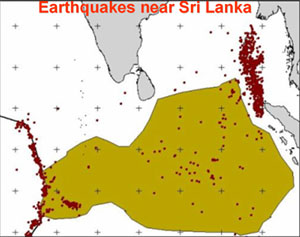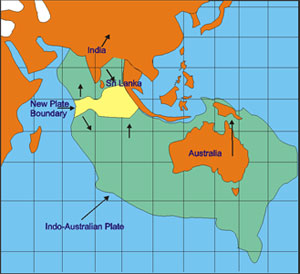The question that every one keeps asking geologists is - “What are the chances of another tsunami occurring in Sri Lanka and is the country now earthquake prone?”
The fear of another tsunami gripped the coastal people in the eastern and southern sectors of the island last week. The enormous calamity that occurred in 2004 culminating in the loss of over 30,000 lives in addition to the complete destruction of house and property in a vast stretch of land, still haunts the people and the fear of its recurrence is very much alive.
Before attempting to answer these questions, it is best to discuss in layman’s terms the geological scenario in and around Sri Lanka which has a clear bearing on the occurrence of earthquakes and tsunamis. It should be mentioned at the very outset that predicting the time and date of future earthquakes and tsunamis is one of the frontiers of scientific research and it will be several decades before one could predict an earthquake within an error of a few years let alone months and days.
Anyone attempting to predict a future earthquake or for that matter even the non-occurrence of one could consider himself dealing more with speculation rather than predictive science. Interestingly, Professor Kerry Sieh, a world renowned earthquake specialist scientist has, after serious study predicted that an 8.8 earthquake in the Richter scale will strike the Indonesian region within a few decades. How few is few was not mentioned. Such is the difficulty in predicting the dates of future earthquakes. The use of the all important phrase “probability of occurrence” is perhaps the best we could do.
Tectonic scenario
around Sri Lanka
The most scientific and logical way of attempting to answer the million dollar question therefore is to consider the probability of an earthquake taking place with obviously a large margin of error based on good geological and geophysical data. This is the reason why the plate tectonic scenario around Sri Lanka has to be considered first.
How do earthquakes occur in the first place? When rocks, mostly situated in the deep interior of the earth undergo compression due to very strong pressure exerted on them by some geological processes, rupture occurs with the release of a large amount of energy, often equivalent to the energy released when atom bombs are exploded. The devastation caused by this release of energy during earthquakes is only too well known.
The vast majority of these earthquakes are located at the boundaries of plates that move about (at the rate of a few cm per year). There are about 12 major plates in the outer shell of the earth and those countries that unfortunately lie close to these boundaries are the vulnerable ones as exemplified by the Japanese Islands, Indonesian Islands, the Philippines among many others.
Sri Lanka lies in the large Indo-Australian plate seemingly far away from any of the plate boundaries. Many people therefore believe that this fortuitous scenario makes Sri Lanka safe from earthquakes.
Recent geological studies, most notably by James Cochoran of the Lamont-Doherty Earth Observatory, however, found convincing evidence for a long suspected geological phenomenon. The Indo-Australian plate is indeed splitting. And guess where it is splitting? Just about 500 -700 km from the southwest coast of Sri Lanka. (see figure).
Cochran shows evidence to show that Australia and India are going separate ways forming a new diffuse plate boundary off the south coast of Sri Lanka. This new plate boundary has apparently been in existence for only seven and a half million years (geologically still quite young!).
The cause of this Indo-Australian split is thought to be the stress suffered by the very large Indo-Australian plate as it smashes into Asia pushing up the Himalayas and the Tibet plateau.
As the mountains reached even higher altitudes, the resistance became too great causing the plate to buckle and split. At present, the Australian part of the plate is moving counter clockwise around a point close to Sri Lanka (see figure), and the Indian plate is moving to the east. One of the interesting aspects of this new plate is that it has both convergent and divergent parts - rather unusual for a single plate! Typical text book articles will mention only the divergent, convergent and sliding types. What does all this geological jargon mean to a layman? It simply means that Sri Lanka is no longer far away from a developing plate boundary. In fact it is now quite close to us.
This is more likely the pivotal point of the new plate boundary. A fair concentration of the recent Indian Ocean earthquakes has originated at this new plate boundary bearing in mind that a number of them were over 7.0 in the Richter scale. The frequency of earth tremors in and around Sri Lanka therefore has to increase (prediction at present as mentioned is still scientifically not satisfactory) and a disastrous earthquake hitting Sri Lanka cannot be ruled out.
The geological processes associated with these plate phenomena are, by human standards, very slow and there lies some hope. Yet, the vulnerability of Sri Lanka to earth tremors is certainly greater than before and all future builders and architects, I am afraid will have to bear this fact in mind.
This geological split in the Indo-Australian plate (now termed the Indo-Australian split) has not yet been fully considered by many geologists. Some even dismiss it by saying that it is not yet established and that it is still in the formative stages. However, the United States Geological Survey, (USGS), one of the foremost geological research institutes in the world, has quite clearly marked the new plate boundary in its world map showing the plates and there is no denying the fact that a plate boundary close to Sri Lanka is indeed developing. The fact that there were several high magnitude earthquakes (over 7.0) in this region so close to Sri Lanka brings very little comfort.
Active plate off the east coast
On the eastern side of Sri Lanka, well over 1000 km away, the major plate boundary that lies close to Indonesia, Sumatra, Nicobar and Andamans is as active as ever. In fact this particular plate boundary is now the most active in the world. The gigantic earthquake over 9.0 in the Richter scale that caused the tsunami in 2004 occurred at this boundary. Quite clearly then, this region is hyperactive and hundreds of earthquakes have occurred over the last few years.
Even though the large earthquakes occurring in that region do not affect Sri Lanka except for minor tremors on account of the distance, a tsunami cannot be ruled out. All earthquakes under the sea do not cause tsunamis, but the probability of one taking effect is quite definitely there. A moderate sized earthquake or a tsunami occurring in Sri Lanka cannot by any means be dismissed as a “one-off “thing or as an “odd-one”.
Many still believe that Sri Lanka is quite safe from earthquakes and that except for minor tremors, no damage could take place. It should however be mentioned here that in 1615, an earthquake occurred in the Colombo area and over 200 deaths had been recorded. What does this mean? It only means that the geological conditions are conducive for a moderate sized earthquake to take place in Sri Lanka. It would be foolish to dismiss it just as a “rare-one”. Indeed many people would have laughed if some said prior to 2004 that a tsunami would strike Sri Lanka and that thousands would perish. Historical records are often dismissed with disdain. In August 1883 a tsunami actually hit Sri Lanka after the Krakatoa volcanic explosion.
 |
A few other points of geological reasoning are important at this juncture. The northern end of the plate in which Sri Lanka lies namely the Himalayan range, is geologically crashing against the Asian plate with such force that it is at a maximum point of stress. This would cause a giant earthquake in the future and many seismologists are expecting it. The stress at this end of the plate will be transmitted across the Indian mainland and Sri Lanka too could be affected by this stress transmission. Such an accumulation of stress within the landmass of Sri Lanka will also cause instability and possibly lead to earth tremors aided by the multitude of fractures and lineaments that criss-cross within Sri Lanka.
More than 25 years ago people hardly talked of earthquakes in Sri Lanka. Now, as every one knows, earth tremors occur quite frequently in Sri Lanka and the trend is more marked than ever before. Could one therefore discount the possibility of at least one moderate sized earthquake that could rattle a few high rise buildings in Sri Lanka ? In my opinion, such a possibility exists and it would be wise for the building industry to take this into consideration.
Yet another point of importance is that the new plate boundary discussed above and developing in the south of Sri Lanka merges with the hyperactive plate boundary close to Indonesia and any stress caused by the rupture there could well be transmitted back into the Indo-Australian diffuse plate towards southern Sri Lanka.
These features in and around Sri Lanka are quite conducive for tsunamis and moderate sized earthquakes. However, we have indeed learnt some harsh lessons from 2004 and we are now in a better position to warn the people of an impending disaster thanks to the National Disaster Management Centre and the Geological Survey and Mines Bureau. Their services should certainly be lauded. There should be no panic when a tsunami warning is issued. We have to learn from the Japanese people who have learnt to live with earthquakes and tsunamis for centuries and who follow strict guidelines during post-event procedures.
(The writer is Director, Institute of Fundamental Studies) |



